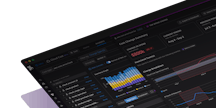- 製品
インフラ
Applications
ログ
セキュリティ
Digital Experience
Software Delivery
Service Management
AI
Platform Capabilities
- お客様
- 料金
- ソリューション
- 金融サービス
- 製造 / 物流
- 医療 / ライフサイエンス
- 流通 / e コマース
- 行政機関
- 文教・教育
- メディア / エンターテインメント
- テクノロジー
- ゲーム業界
- アマゾン ウェブ サービス (AWS)
- Azure Monitoring
- Google Cloud Monitoring
- Oracle Cloud Monitoring
- Kubernetes Monitoring
- Red Hat OpenShift
- Pivotal プラットフォーム
- OpenAI
- SAP Monitoring
- OpenTelemetry
- Application Security
- クラウド移行
- モニタリング統合
- Unified Commerce Monitoring
- DevOps
- シフトレフト テスト
- デジタル エクスペリエンス モニタリング
- セキュリティ アナリティクス
- CIS ベンチマーク コンプライアンス
- ハイブリッドクラウドモニタリング
- IoT モニタリング
- リアルタイム BI
- オンプレミス モニタリング
- ログ分析と相関
- CNAPP
Industry
テクノロジー
Use Case
- 会社情報
- ブログ
- ドキュメント
- ログイン
- 始める
Software Development
51–200 Employees
Durham, NC
会社情報 Kevel
Kevel builds infrastructure APIs companies can use to quickly create custom advertising platforms. The company is committed to helping customers drive new revenue.
“Cost is a need, just as scale and security and everything else are. Engineers have to care about it.”

Tim Ewald
Chief Technology Officer
Kevel

“Cost is a need, just as scale and security and everything else are. Engineers have to care about it.”
Tim Ewald
Chief Technology Officer
Kevel
なぜDatadogなのか?
- Accelerates visibility and reporting by centralizing cloud costs
- Reduces time to detect overages and investigate cost changes by unifying spend and observability data in a single view
- Encourages engineers to take ownership of costs by providing cost data where they need it and on the services they own
Challenge
Kevel needed to scale dynamically while maintaining cost-efficiency. That required the company to combine observability data with cost context.
Use Case
主な成果
↓$50,000–$100,000
Reduced AWS monthly spend
Weeks → Days
Time required to trace a cost increase
Lack of visibility into cloud costs hampers efficiency
Kevel is an adtech company that creates APIs to enable organizations to quickly and easily build and manage their own custom advertising platforms in lieu of using services like Google Ads or Amazon. Unlike many of its competitors, Kevel provides this service on a subscription basis rather than charging a percentage of ad revenue. This is a key differentiator that allows Kevel to deliver more value to its customers.
Kevel is cloud-native (100 percent on AWS) and runs 24/7 across nine data centers worldwide. Scale is critical, as the company makes an average of 40 billion decisions on when to deliver ads—and to whom—in one month, but can quickly scale to much higher request rates.
Kevel faced two primary challenges. First, its engineering team needed strong observability for its services and sufficient scale to support its infrastructure. Secondly, there was an ongoing push from the company’s board to improve efficiency and control costs. “We need features to attract customers, and we also have to meet our investors’ needs. The unit economics have to be right,” says Tim Ewald, chief technology officer at Kevel. “In adtech, efficiency is a product differentiator. If you’re efficient you can provide more value to your customers.”
A crucial element to achieving that efficiency is the ability to understand and act on cloud costs effectively. The company previously used two cost management tools. One provided a daily email report with pricing changes and projected end-of-month costs. The other tool, AWS Cost Explorer, didn’t enable Kevel to split costs by resource. With both tools, engineers had to go out of their way to look for cost data, and most didn’t. “It was easy to fall into the pattern of looking at cost spikes at the end of the month after it was too late to do anything about it,” says Ewald.
Typically, Ewald or the company's CEO would flag cost spikes on an ad hoc basis. In some cases, weeks passed before anyone noticed a spike. In order to maintain the efficiency Kevel needed to serve both its customers and investors, Ewald needed an easy way to get cost data into engineers’ hands so they could see the effects of changes quickly and begin to think about cost impacts earlier.

“Cost can be a canary in a coal mine, and some AWS costs are really hard to understand. With Datadog, we have an overview dashboard and graphs to each component to ensure costs reflect what we were expecting.”
Finding the canary in the coal mine
Kevel was an early adopter of Datadog—from Infrastructure Monitoring and custom metrics to Log Management—and recently added Real User Monitoring (RUM) as well. To improve insight into its cloud costs as it grew, Kevel added Datadog Cloud Cost Management. For Ewald, it’s not just about finding opportunities to cut costs when it makes sense. “Cost is a need, just as scale and security and everything else are. Engineers have to care about it,” he says. “If you don’t hit your goals in terms of margin, [no one will ask], ‘does it scale enough?’”
Datadog Cloud Cost Management provides easy visibility into cloud costs and enables Kevel engineers to mix cost visualizations with other metrics in a single dashboard. “Cost can be a canary in a coal mine, and some AWS costs are really hard to find. With Datadog, we have an overview dashboard and graphs to each component to ensure it reflects what we were expecting,” says Ewald. “As we scale out a customer, costs typically grow in a linear fashion. With Cloud Cost Management, we can see when there is a spike. If we don’t see a correlated system growth, we know we need to check into it.”
For example, a Kevel engineering team recently rolled out an architectural change in AWS that generated a cost spike. Datadog Cloud Cost Management helped them quickly find and identify the issue. “We didn't have a good way to do this kind of analysis before,” says Ewald. “Being able to mix cost and metrics data in a single dashboard makes these kinds of relationships visible in days, not weeks.”
Ewald adds that Datadog Cloud Cost Management adoption was easy. “Our engineers live in Datadog when they look at the system’s health,” says Ewald. “Being able to add cost data into a Datadog dashboard means cost becomes another thing that they review and consider as they work.”
Creating a cultural shift
Since it began using Datadog Cloud Cost Management, Kevel has reduced its monthly AWS spend by between $50,000 and $100,000. “The latest Amazon tools allow you to build things fast, but it might also turn out to be extremely expensive,” says Ewald. “Datadog Cloud Cost Management makes it very easy to understand their relationships.”
Improved visibility means Kevel engineers can now react proactively to unexpected cost changes and avoid unpleasant surprises. This has created a cultural shift within the company as engineers begin to take ownership of the cost of their services. Ultimately, Datadog Cloud Cost Management enables Kevel to keep closer tabs on its margins and continue to strive toward better efficiency. “Having efficiency built into the business from the beginning is a huge strategic advantage for us,” says Ewald. “Two things have to be there for us to operate our system: AWS is one; Datadog is the other.”

